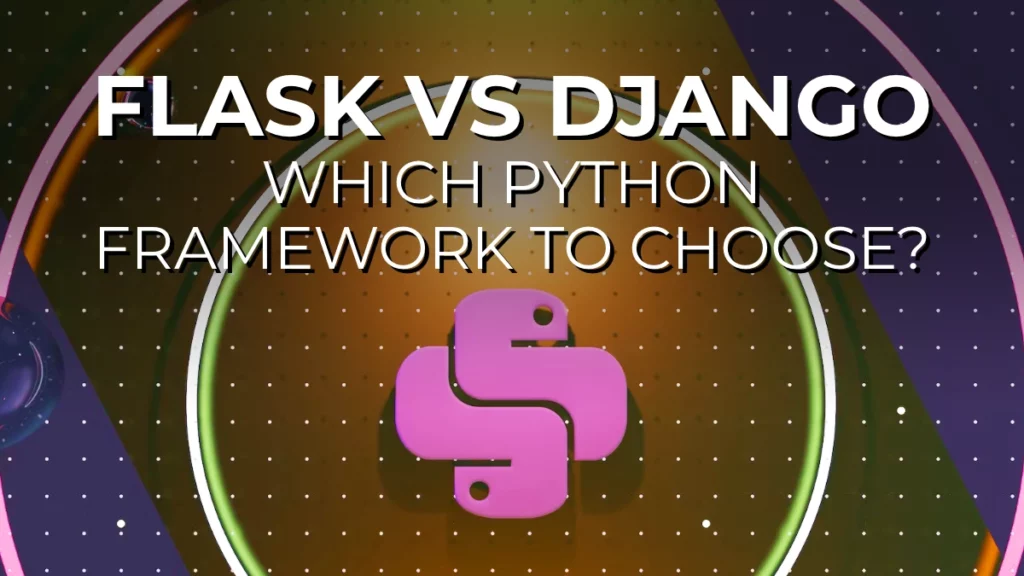Flask and Django have long been two of the most prominent web frameworks in the Python world. But with each year that passes, advancements and changes shift the scales.
In this 2023 guide, we delve deep into the differences between Django and Flask, exploring their advantages, drawbacks, and unique features. If you’re unsure about which framework suits your next web app best, read on.
Key Takeaways
- Flask is a micro-framework suitable for small to medium applications, offering more flexibility.
- Django is a full-stack Python framework ideal for larger applications, providing many out-of-the-box features.
- The choice between Flask and Django should be based on the project’s requirements and the developer’s personal preferences.
1. What is Flask and Django?
At the core, both Django and Flask are popular Python web frameworks written in the Python programming language, facilitating web development tasks.
Flask is a micro-framework, lightweight and straightforward. Flask provides developers with flexibility, allowing them to use any kind of third-party tools and libraries. In terms of its structure, Flask is based on the Werkzeug toolkit and Jinja2 template engine. When you think of Flask as a Python web framework, it’s the simplicity and modularity that often come to mind.
Django, on the other hand, is a free, full-stack web framework that offers a more comprehensive solution. Django comes with its own ORM, admin panel, and many built-in features that make it easier to develop web applications. When Django was born, its main aim was to make web development faster and easier. With its “batteries-included” philosophy, Django provides many tools right out of the box.
2. What Are The Differences Between Flask and Django?
Flask, being a micro-framework, doesn’t come loaded with as many out-of-the-box features as Django. However, Flask provides support for extensions, allowing developers to add functionality as they see fit. Popular features include:
- Flask supports RESTful request dispatching.
- It uses Jinja2 to render templates.
- Built-in development server and a fast debugger.
Django, as a full-stack framework, has a wide array of built-in functionalities. Some key features include:
- Django ORM that allows for database operations without writing SQL.
- Built-in admin panel for content management.
- Robust security features.
- Django Rest Framework for building APIs.
3. Why Use Flask or Django? The Advantages
Advantages of Flask:
- Flexibility: Flask will make your life easier if you want a minimalistic framework where you can plug and play third-party applications.
- Learning Curve: For those new to web development, they often find Flask easier than Django. It’s usually recommended to start with Flask before Django for this reason.
- Performance: For small-scale applications, Flask can offer faster performance due to its lightweight nature.
Advantages of Django:
- Batteries Included: Django provides a myriad of tools ready for use, making the web development process smoother.
- Security: Django has robust security measures, shielding developers from many common security mistakes.
- Community and Documentation: Having been around for a longer period, Django has a vibrant community and extensive documentation, aiding developers in their journey.
4. The Downsides: Disadvantages of Flask and Disadvantages of Django
Disadvantages of Flask:
- Not Suitable for Large Applications: Being a micro-framework, Flask is suitable for small to medium-scale applications. For more extensive applications, it might require a lot of plugins, making the process cumbersome.
- Less Structured: For developers who prefer a clear structure, Flask’s flexibility might be a disadvantage.
Disadvantages of Django:
- Learning Curve: Because of Django’s comprehensive nature, learning Django is a bit slower and harder than learning Flask.
- Less Flexible: The opinionated nature of Django might be a drawback for some developers who want more control over components.
5. Django or Flask: Which Framework to Choose for Your Project?
The choice between Flask and Django often boils down to the project’s needs and the developer’s preferences. If you’re building a small web application or wish to have more control over the components you use, Flask might be the better choice. On the other hand, if you’re looking for a framework that offers a wide range of built-in features and is suitable for larger applications, you probably should use Django.
Conclusion
Whether you opt for Flask or Django, both frameworks are powerful tools in the hands of Python developers, promising to make the web development journey smoother and more efficient.
